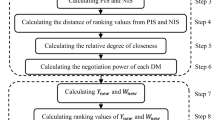Abstract
In watershed ecological risk management, a series of alternatives will be analyzed in terms of multiple complex criteria, and different stakeholders with conflicting risk attitudes will be involved, which means that ecological risk management decision-making is a process surrounded by a wide range of uncertainties derived from scarcity of data, lack of knowledge, deficiency of assumptions and lexical vagueness. Based on modified Borda scoring method, this paper discusses how to apply a fuzzy multi-criteria group decision-making (FMCGDM) model into such a process. Then, a two-stage, 12-step MCDM methodology is proposed to obtain the optimal alternative decided by multiple decision-makers (DMs) from a given alternatives set. Firstly, all DMs make their own independent choice respectively, then, all the independent conclusions are integrated by using their subjective/objective weights. A modified Borda method is followed to rate and rank the weighted alternatives; in which the one with the highest score will be selected as the final preferable option. This model is demonstrated to be applicable and reliable by an application in the ecological risk decision making process of Three Gorges Reservoir area located in the upper reaches of Yangtze River in China. Of course, this method can also be applied in other research fields of environmental management.
Similar content being viewed by others
References
Abrishamchi A, Ebrahimian A, Tajrishi M, Marino MA (2005) Case study: application of multi-criteria decision making to urban water supply. J Water Resour Plan Manage 131:326–335
Accorsi R, Apostolakis GE, Zio E (1999a) Prioritizing stakeholder concerns in environmental risk management. J Risk Res 2:11–29
Accorsi R, Zio E, Apostolakis GE (1999b) Developing utility functions for environmental decision-making. Prog Nucl Energy 34:387–411
Anderson K (2005) Intelligence-based threat assessments for information networks and infrastructures: a white paper, network risk management, LLC
Apostolakis GE (2001) Expert judgment resolution in technically-intensive policy disputes. In: Linkov I, Palma-Oliveira J (eds) Assessment and management of environmental risks: cost-efficient methods and applications. Proceedings of the NATO advanced research workshop Boston, MA, USA. Kluwer Academic Publishers
Bender MJ, Simonovic SP (2000) A fuzzy compromise approach to water resources systems planning under uncertainty. Fuzzy Sets Syst 115:35–44
Brito AJ, de Almeida AT (2009) Multi-attribute risk assessment for risk ranking of natural gas pipelines. Reliab Eng Syst Saf 94:187–198
Bonano EJ, Apostolakis GE, Salter PF, Ghassemi A, Jennings S (2000) Application of risk assessment and decision analysis to the evaluation, ranking and selection of environmental remediation alternatives. J Hazard Mater 71:35–57
Chen SY (1998) Engineering fuzzy set theory and application [M]. National Defense and Industry Press, Peking (in Chinese)
Chen JQ, Wang H, Yang XL (2002) Science of water resources. [M]. Science, Peking (in Chinese)
Gregory R, McDaniels T, Fields D (2001) Decision aiding, not dispute resolution: creating insights through structured environmental decisions. J Policy Anal Manage 20:415–432
Gu PL (1998) System analysis and coordination [M]. Tianjin University Press, Tianjinin (in Chinese)
Hamalainen RP, Lindstedt M, Sinkko K (2000) Multi-attribute risk analysis in nuclear emergency management. Risk Anal 20:455–468
Harwell MA, Harwell CC, Kelly JR (1986) Regulatory endpoints, ecological uncertainties, and environmental decision-making. OCEANS 86:993–998
James WM (1999) A method for quantitative risk analysis’. Proceedings of the 22nd national information systems security conference. http://www.csrc.nist.gov/nissc /1999/proceeding/ papers /p28.pdf
Kong F (2008) Theory, methodology and application of fuzzy multiple criteria decision making [M]. Chinese Agricultural Science and Technology Press, Peking (in Chinese)
Lahdelma R, Hokkanen J, Salminen P (1998) SMAA-Stochastic multiobjective acceptability analysis. Eur J Oper Res 106:137–143
Liu X, Wirtz KW (2007) Decision making of oil spill contingency options with fuzzy comprehensive evaluation. Water Res Manag 21:663–676
Michaud D, Apostolakis GE (2006) Methodology for ranking the elements of water-supply networks. J Infrastruct Syst 12:230–242
Miller J (2002) Risk management for your web site. International risk management institute expert commentary. http://www.irmi.com/expert/articles/schoenfeld003.asp (10 December 2002)
Pavlou SP, Stansbury JS (1998) Risk-cost trade off considerations for contaminated sediment disposal. Human Ecological Risk Assessment 4:991–1002
Prato T (2003) Multiple-attribute evaluation of ecosystem management for the Missouri River system. Ecol Econ 45:297–309
Stansbury J, Member PE, Bogardi I, Stakhiv EZ (1999) Risk-cost optimization under uncertainty for dredged material disposal. Water Resource Planning Management 125:342–351
Tesfamariam S, Sadiq R (2006) Risk-based environmental decision-making using fuzzy analytic hierarchy process (F-AHP). Stoch Environ Res Risk Assess 21:35–50
U.S. EPA (1992) Framework for ecological risk assessment. U.S. Environmental Protection Agency, Risk Assessment Forum, Washington, DC, EPA/630/R-92/001
U.S. EPA (1998) Guidelines for ecological risk assessment. U.S. Environmental Protection Agency, Risk Assessment Forum, Washington, DC, EPA/630/R095/002F
[USEPA SAB] US Environmental Protection Agency Science Advisory Board (2007) Advice to EPA on advancing the science and application of ecological risk assessment in environmental decision making: a report of the U.S. EPA Science Advisory Board. Washington, DC, USEPA, EPA/SAB/08/002
Wang HM (2000) Watershed Sustainable development system theory and methods. [M]. Hohai University Press, Nanjing (in Chinese)
Wetmore WR III, Summers J (2003) Group decision making: friend or foe? Engineering management conference, IEMC ‘03, Managing technologically driven organizations: the human side of innovation and change
Yu YB, Wang BD (2004) Multi-person multiobjective fuzzy decision-making model for reservoir flood control operation. Water Resour Manag 18:111–124
Author information
Authors and Affiliations
Corresponding author
Rights and permissions
About this article
Cite this article
Fanghua, H., Guanchun, C. A Fuzzy Multi-Criteria Group Decision-Making Model Based on Weighted Borda Scoring Method for Watershed Ecological Risk Management: a Case Study of Three Gorges Reservoir Area of China. Water Resour Manage 24, 2139–2165 (2010). https://doi.org/10.1007/s11269-009-9544-9
Received:
Accepted:
Published:
Issue Date:
DOI: https://doi.org/10.1007/s11269-009-9544-9




